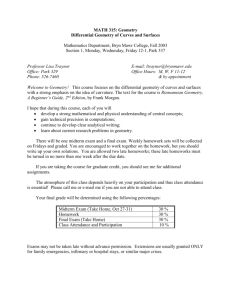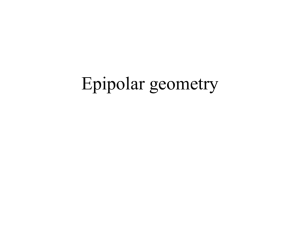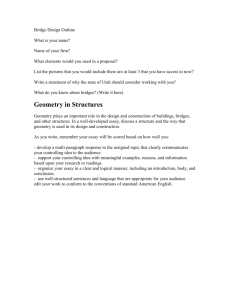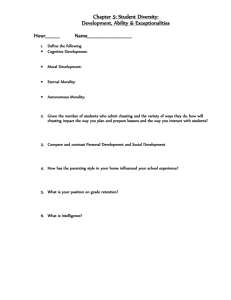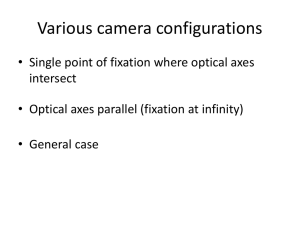Syllabus 2009 - Computer Vision and Pattern Analysis Laboratory
advertisement
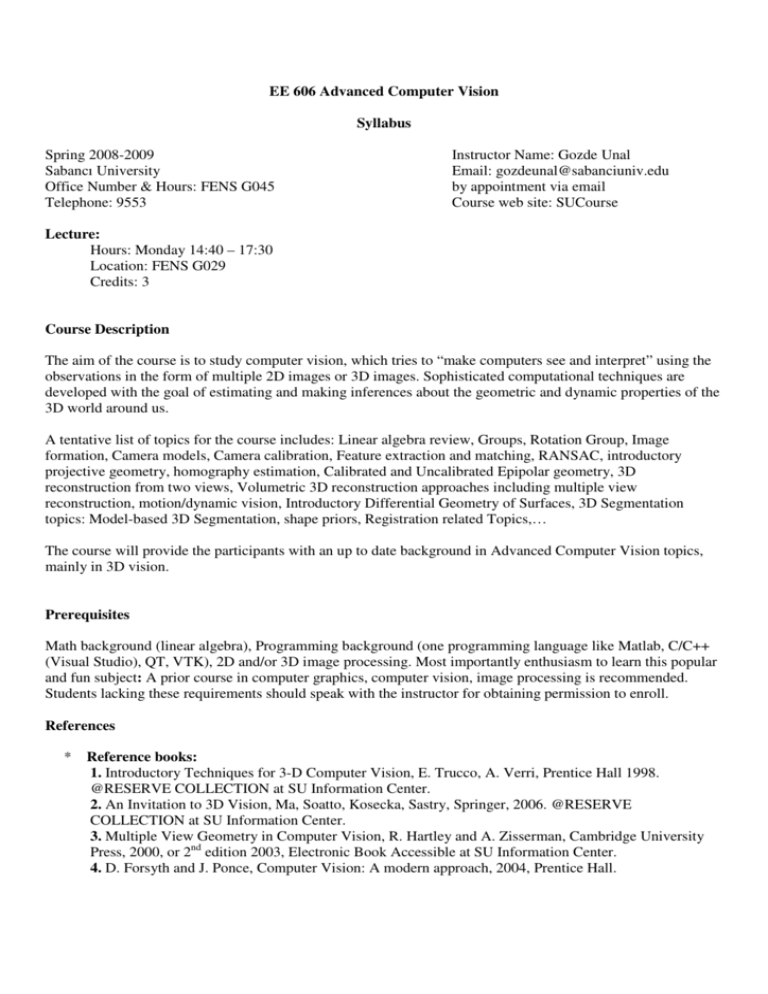
EE 606 Advanced Computer Vision Syllabus Spring 2008-2009 Sabancı University Office Number & Hours: FENS G045 Telephone: 9553 Instructor Name: Gozde Unal Email: gozdeunal@sabanciuniv.edu by appointment via email Course web site: SUCourse Lecture: Hours: Monday 14:40 – 17:30 Location: FENS G029 Credits: 3 Course Description The aim of the course is to study computer vision, which tries to “make computers see and interpret” using the observations in the form of multiple 2D images or 3D images. Sophisticated computational techniques are developed with the goal of estimating and making inferences about the geometric and dynamic properties of the 3D world around us. A tentative list of topics for the course includes: Linear algebra review, Groups, Rotation Group, Image formation, Camera models, Camera calibration, Feature extraction and matching, RANSAC, introductory projective geometry, homography estimation, Calibrated and Uncalibrated Epipolar geometry, 3D reconstruction from two views, Volumetric 3D reconstruction approaches including multiple view reconstruction, motion/dynamic vision, Introductory Differential Geometry of Surfaces, 3D Segmentation topics: Model-based 3D Segmentation, shape priors, Registration related Topics,… The course will provide the participants with an up to date background in Advanced Computer Vision topics, mainly in 3D vision. Prerequisites Math background (linear algebra), Programming background (one programming language like Matlab, C/C++ (Visual Studio), QT, VTK), 2D and/or 3D image processing. Most importantly enthusiasm to learn this popular and fun subject: A prior course in computer graphics, computer vision, image processing is recommended. Students lacking these requirements should speak with the instructor for obtaining permission to enroll. References * Reference books: 1. Introductory Techniques for 3-D Computer Vision, E. Trucco, A. Verri, Prentice Hall 1998. @RESERVE COLLECTION at SU Information Center. 2. An Invitation to 3D Vision, Ma, Soatto, Kosecka, Sastry, Springer, 2006. @RESERVE COLLECTION at SU Information Center. 3. Multiple View Geometry in Computer Vision, R. Hartley and A. Zisserman, Cambridge University Press, 2000, or 2nd edition 2003, Electronic Book Accessible at SU Information Center. 4. D. Forsyth and J. Ponce, Computer Vision: A modern approach, 2004, Prentice Hall. * Related Conferences: IEEE CVPR (Computer Vision and Pattern Recognition Conference), IEEE ICCV (Int. Conf. Computer Vision), ECCV (European Conference on Computer Vision), 3DIM (Int. Conf. on 3-D Digital Imaging and Modeling), 3DPVT (3-D Data Processing, Visualization and Transmission),… * Related Journals: IEEE Transactions on Pattern Analysis and Machine Intelligence (PAMI), International Journal of Computer Vision, Journal of Mathematical Imaging and Vision, Computer Aided Design,… Grading (Tentative Evaluation) Homework Assignments 35% Class Participation 5% Midterm (=Final) Exam 25% Course Project Write-up and Innovation 15% Project Implementation 10% Course Project Presentation and Demo 10% Course Project Timeline (deadlines): March 16: Decide your topic (or the paper on which you want to build and improve) April 6: First progress report with literature review and a clear Outline of your paper and method May 11: Second progress report with method and preliminary results (should be roughly getting closer to its final form) End of May: Final project submission and presentation Tentative Course Schedule Week 1 Date Feb 16 Topic Introduction to Computer Vision Image Formation Camera Models Linear Algebra Review Rigid-body Motion Projective Plane: introduction 2 3 Feb 23 Mar 2 4 5 Mar 9 Mar 16 No class Projective Geometry: more intro Camera Calibration 6 7 Mar 23 Mar 30 Homography Estimation Calibrated Epipolar Geometry 3D Reconstruction 8 Apr 6 9 Apr 13 10 11 Apr 20 Apr 27 12 13 May 4 May 11 14 May 18 15 May 25 Uncalibrated Epipolar Geometry 3D Reconstruction 3D Reconstruction Wrapup/Volumetric approaches Spring Break Diff Geom. of Curves and Surfaces EXAM Recent developments in using variational methods and PDE's to represent and recover surfaces, Implicit Shape Representations (level sets), Model-based Segmentation, shape priors, … Graph cuts etc Motion/Dynamic Images Shape from X Registration, stitching, morphing Reading [TruccoVerri] 2.2, 2.4 Assignment/Notes [MaSoatto] Chap 2 [Hartley] Chap 3 Unal @ SIAM conference [TruccoVerri] Chap 6, Zhang’s Cam. Calibration No Class Each week: Monday Block Course Note: This syllabus and schedule are subject to change. If you are absent from class, it is your responsibility to check on announcements made while you were absent. Course Policies Discussions among students for course assignments and projects are encouraged. However, what you submit should be output of your own efforts and work. Cheating and Plagiarism: "Cheating is the actual or attempted practice of fraudulent or deceptive acts for the purpose of improving one's grade or obtaining course credit; such acts also include assisting another student to do so. Typically, such acts occur in relation to examinations. However, it is the intent of this definition that the term 'cheating' not be limited to examination situations only, but that it include any and all actions by a student that are intended to gain an unearned academic advantage by fraudulent or deceptive means. Plagiarism is a specific form of cheating which consists of the misuse of the published and/or unpublished works of others by misrepresenting the material (i.e., their intellectual property) so used as one's own work." Penalties for cheating and plagiarism range from a 0 or F on a particular assignment, through an F for the course, to expulsion from the university. You can find some related links at the SU web page Ethics in Science: http://www.sabanciuniv.edu/mdbf/eng/OgretimUyeleri/BilimselAhlakKurallari.html Disruptive Classroom Behavior: "The classroom is a special environment in which students and faculty come together to promote learning and growth. It is essential to this learning environment that respect for the rights of others seeking to learn, respect for the professionalism of the instructor, and the general goals of academic freedom are maintained. … Differences of viewpoint or concerns should be expressed in terms which are supportive of the learning process, creating an environment in which students and faculty may learn to reason with clarity and compassion, to share of themselves without losing their identities, and to develop an understanding of the community in which they live. … Student conduct which disrupts the learning process shall not be tolerated and may lead to disciplinary action and/or removal from class."

